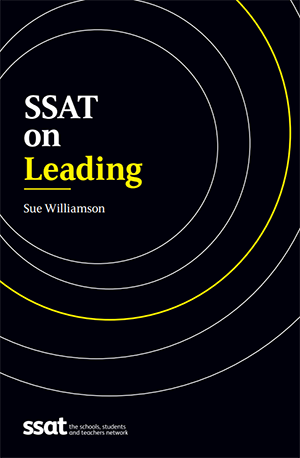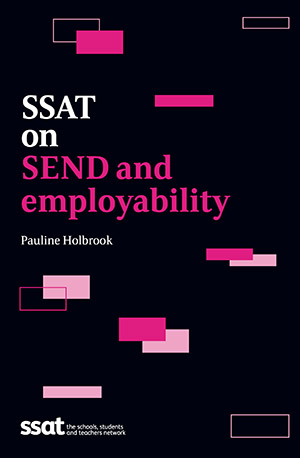SSAT on SEND and employability
Pauline Holbrook, Head of SEND, SSAT
It’s not right that so few young people with SEND are able to gain employment – especially as those that do, often become valuable employees, as well as gaining fulfilment.
Pauline Holbrook has written from the premise that all learners have the ability to learn and that we need to have high aspirations for each and every learner and acknowledge that employment is a real possibility. This pamphlet is designed to encourage discussion about employability and gives many examples of how schools can support SEND learners into the world of work.
Skills such as using public transport, handling money, understanding body language and how to behave in a work situation need to be explicitly taught to the majority of SEND learners and therefore need to feature within their personalised learning offer.
A key role of schools is to prepare students for the next steps on their life journey. Sue Williamson in SSAT’s Fighting for Deep Social Justice pamphlet emphasises the school’s role in ensuring that all learners, whatever their ability or context, leave school fully prepared to lead fulfilled and purposeful lives.
SSAT believes that schools should have high aspirations for all learners and that the achievements of all learners should be celebrated not just those who achieve 5 good GCSE’s. For SEND learners we must ask ourselves what is an appropriate curriculum offer? How can we include aspects of work-related learning? What are the learner’s aspirations and what can we do to help them achieve them?
SSAT on Curriculum

£12.50
Order now
Tom Middlehurst, Head of Policy and Public Affairs, SSAT
Curriculum: the ‘lived daily experience of young people in and out of the classroom’
Discussions around curriculum are sometimes divisive and hotly argued. What is surprising, perhaps, is how infrequently these ideas are discussed at a school level and result in positive changes in the school curriculum – especially considering that the vast majority of educators would agree with Dylan Wiliam’s definition, above, which emphasises the crucial nature of a school’s curriculum. The real curriculum is always created by teachers, or indeed any individuals coming into contact with students, rather than politicians or even school leaders.
This pamphlet is designed to prompt discussion in schools and introduce SSAT’s Four Pillars of Curriculum Design as well as the seven principles of a good curriculum outlined in Dylan Wiliam’s SSAT pamphlet, Principled Curriculum Design.
While it is the government’s prerogative to determine the national curriculum, school leaders and teachers have the right to enact this as they see fit, based on their professional expertise. A national curriculum is a powerful tool for social justice; it ensures that all young people, in theory, have access to the same knowledge, understanding and experiences, regardless of where they come from or where they go to school. This has to be welcomed.
But there must also be room for local contextualisation and content. The percentage of the school curriculum that should be defined centrally is always open for debate – and readers will have different views on this. The fact remains that, compared to many education systems, English schools have a great degree of freedom on what their curriculum looks like, and how they deliver it. So teachers and school leaders have it in their power to provide a curriculum that best serves their students’ needs.
SSAT on Future Learning

£12.50
Order now
Alex Galvin, Senior Education Lead, SSAT
Technology has changed how we learn and how we acquire knowledge. We have immediate access to unimaginable amounts of information at the touch of a button. Arguably, the democratisation of learning is now more dependent on access to technology than access to books and other resources.
But how should schools, and the education system generally, respond to this dramatic shift?
In May 2017 SSAT led ‘future learning’ seminars around the country with Dr William Rankin, director of Unfold Learning and until recently the worldwide director of learning at Apple. This publication is a culmination of those discussions, our extensive work in the field of curriculum and learning and Dr Rankin’s most recent research. It also aims to capture some of the wisdom shared by our member schools during this process and offer further food for thought.
The oft-repeated line that we are ‘preparing young people for jobs that may not yet exist’ has fed into an ongoing ‘knowledge vs skills’ debate. Does a knowledge-based curriculum lose its relevance if we cannot structure the content to support future employability? If we focus on skills, are we dumbing down and denying our young people access to cultural capital? But in truth, consideration of future learning cannot be about knowledge vs skills.
Clearly any attempt to develop skills without also focusing on acquiring and applying knowledge will be a hollow exercise, as this pamphlet clearly demonstrates. It offers seven key skills and qualities for future success: lifelong learning and personal responsibility for skills development; selfmotivation and flexibility; effective communication skills; ability to transfer knowledge and skills; ability to work collaboratively; creativity and problem solving; and analytical skills.
It explains the vital role of these skills and qualities and how they are best applied in education, with summaries of the key conclusions and recommendations from some of the world’s best researchers and thinkers in this area. The pamphlet ends with 12 key recommendations for future learning.
SSAT on the School-led System

£12.50
Order now
Sue Williamson, Chief Executive, SSAT
Education in England is still in a transitional phase of moving to a school-led system. SSAT has long been an advocate of schools leading the system, in partnership with other stakeholders.
Despite a number of government initiatives in recent years, with academies, then multi-academy trusts and regional schools commissioners, there has not been enough open discussion on how we might realise the school-led system. If it was successful, the school-led system would ensure a high quality of education in every school throughout the country. This would require that each school took significant responsibility for the education of other schools in its locality, as well as of its own students.
But there is no clarity about the framework needed to ensure that the school-led system succeeds within sensible accountability measures – locally and nationally.
SSAT wants the school-led system to be successful, but recognises the challenges the system faces. One of the most crucial of these is determining the middle tier: how can we ensure that all schools meet the needs of a locality and are accountable to that community?
This pamphlet by SSAT chief executive Sue Williamson examines three possibilities for the vital role of the middle tier: local authorities, regional schools commissioners, and local area partnerships. She considers evidence from expert sources with detailed experience of each of these sectors on their strengths and challenges. She argues that local area partnerships could prove to be the best for returning power to a locality. Among other benefits, they can offer targeted hands-on support to schools, a buffer between schools and the centre, and a channel to share and integrate improvements across schools.
Among the implications she considers is what contribution local authorities, MATs and regional commissioners could make to this solution.
Throughout this pamphlet, Sue Williamson offers clear evidence-based rationale and argument for her position, but also an openness to alternative views, with key points and thoughts for discussion.
SSAT on Leading

£12.50
Order now
Sue Williamson, Chief Executive, SSAT
What leadership is needed in the school-led system? Are multi-academy trusts (MATs) really the best way forward and what should be their key features? What lessons might school leaders learn from other sectors?
Sue Williamson starts this pamphlet to address these crucial issues by reaffirming that we at SSAT would agree that collaboration is essential if England is to have a world-class system of schooling.
She outlines the progressive, and changing, challenges that face leaders in education as they develop within a school, to head a school and then a group of schools. However, while such status hopefully indicates a system leader in education, Sue is clear that heads and middle leaders in individual schools can also be system leaders.
The pamphlet includes in-depth comments by school leaders at different stages, with their evaluations of different approaches and routes to leadership and ways to tackle the challenges. Together, these help to clarify the constantly shifting educational scene.
An issue that has become ever more vital is: where can system leaders acquire the wider range of skills they need as they progress in this more complex environment? Sue addresses the need for business skills, which she concedes is a difficult subject for many school leaders “– but I do believe that we can take lessons from the business world and shape them for MATs and single institutions.”
The pamphlet goes on to show which business skills are needed, and why: for example, for central services, planning for growth, due diligence, financial risk management, data capture systems and processes, and the development of flexible growth plans. Not to mention political acumen and interpersonal skills in managing adversity. So leadership programmes need to engage with sectors outside education in order to bring the very best practice and ideas into the schooling system.
Sue Williamson ends this pamphlet by setting out “who needs to do what” in leading education.

